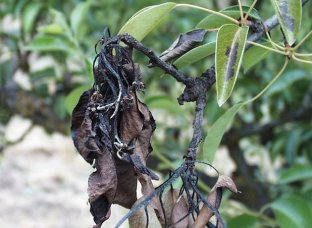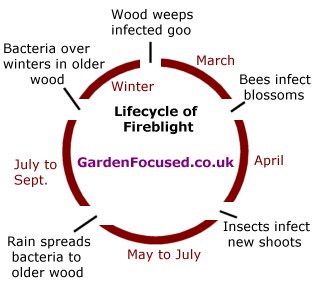SYMPTOMS OF FIREBLIGHT
The symptoms of fireblight are hard to miss even at the initial stages of infection. First the blossoms are infected then new shoots, fruit and finally the main branches can be affected. The key symptoms are:
- Blossoms quickly die off turning a dark brown colour
- New shoots then become infected a week or so later and they too wither and blacken although they tend to remain on the tree. Some shoots may randomly be completely unaffected.
- If the weather is warm and wet the affected shoots begin to weep a sticky goo which is laden with bacteria
- Developing fruits then wither and die
- This year’s wood growth is then infected and this turns black and begins to die
- If the tree or shrub is not treated the infection then affects wood from previous years’ growth and at this stage the tree will almost certainly die.
Fireblight does not attack plum, greengage, cherry, apricot or peach trees.
With pear trees in particular, the infection of blossom stage can sometimes not occur, the first signs being noticed on new shoots. This is because pear blossom tends to appear a week or two earlier than on apple trees when the conditions are not yet warm enough for the bacteria to flourish.

Picture of Fireblight from Stark Bros
LIFE CYCLE OF FIREBLIGHT
Fireblight affects apple and pear trees as well as other plants. The most important of those are hawthorns because these are so common in the UK that the bacteria can spread large distances using hawthorn hedges as their main vehicle. The bacteria first arrived in the UK in 1957 from North America. Currently in the UK fireblight is common on southern and warmer areas and less common in northern areas where cooler temperatures don’t suit the lifecycle of this bacteria.
Infected branches from the previous year begin to weep bacterially infected goo which is transferred to blossoms and new shoots by bees and other insects. The infections early in the year are spread by bees feeding on infected blossoms. Later in the year when new shoots weep infected goo, the bacteria is spread by insects and rain. Blossom and new shoots very quickly show signs of infection although older wood takes longer to be infected. However it is on old wood that the bacteria overwinter ready to restart the infection cycle next year. The diagram below is a graphical representation of the lifecycle.

HOW TO TREAT FIREBLIGHT OF APPLES AND PEARS
There is no magic cure for fireblight and with trees 4 years old or younger it is probably best to dig them up, destroy them and start again with a resistant variety. The list below describes the key prevention and damage limitation measures that can be used:
- If you are in an area which is known to have fireblight, by far the most effective course of action is to grow varieties with some resistance. See the list at the end of this article for apple and pear trees which show resistance although there are no varieties which are totally immune
- There are no chemical sprays available in the UK to treat fireblight. Copper fungicide sprays were available a few years ago but they have been withdrawn from sale.
- As soon as you confirm that there is fireblight remove all infected shoots and \ blossom. Cut away any infected wood at least 15cm / 6in further back from the infection. This may result in a badly shaped tree but if not done the tree will almost certainly die. Scrupulously remove all prunings and infected material well away from the infected tree and burn it.
APPLE AND PEAR TREES WITH RESISTANCE TO FIREBLIGHT
No apple or pear trees are fully resistant to this bacteria but some varieties do show some resistance.
PEAR TREES RESISTANT TO FIREBLIGHT
There are no pear tree varieties available in the UK which are totally resistant to fireblight. Concorde does show some resistance however. Varieties normally grown outside the UK which are resistant to fireblight include:
- Seckel – an old American variety which shows some resistance
- Moonglow – although not resistant to fireblight it seems to respond to treatment better than others.
APPLE TREES RESISTANT TO FIREBLIGHT
There are no apple tree varieties available in the UK which are resistant to fireblight. Anyone who tells you differently is pulling the wool over your eyes, so beware! Common belief is that early flowering trees do better than later flowering ones although we have found no evidence of scientific trials to prove or disprove this.
COMMENTS / QUESTIONS LEFT BY OUR READERS
| Date: 18 October 2017 | From: Sara |
| QUESTION: My pear tree Doyenne du Comice went black overnight it’s October could this still be fireblight?
ANSWER: It’s a bit late in the year for fireblight but I know of no other disease which would turn a pear tree black as quick as you describe. My guess is that you live in the warmer south of England, possibly the recent few warm days caused by hurricane Ophelia awoke some spores. You can now only wait until to next spring to see if the tree survives. As soon as you get an inkling that it might be dead, cut it down and have a bonfire. Apologies for the potentially bad news. |
|
| Date: 6 October 2016 | From: Mike |
| QUESTION: My pear tree has fireblight and pear tree rust. It is an old tree I inherited when I took over the plot. I have had no fruit for two years. Is it worth saving or should I get rid? identified?
ANSWER: My advice would be to get rid of it. Older trees rarely recover from fireblight. |
|
| Date: 11 August 2015 | From: Not Given |
| QUESTION: Which stage can the fire blight disease can be easily identified?
ANSWER: At the second stage which is: “New shoots then become infected a week or so later and they too wither and blacken although they tend to remain on the tree. Some shoots may randomly be completely unaffected.” |
|
WHY NOT LEAVE YOUR QUESTION / COMMENTS ABOUT THIS PAGE?
ENTER THEM BELOW. EMAIL ADDRESS IS OPTIONAL.
YOUR COMMENTS WILL BE ADDED ABOVE WITHIN A FEW HOURS.
[contact-form-7 id=”1882″ title=”Contact form 1″]
FIREBLIGHT OF APPLES AND PEARS
By David Marks
Fireblight (Erwinia amylovora) gets its name from the appearance of trees and shrubs which have been badly infected by this bacteria. Leaves and sometimes even the stems look like they have been badly burnt by fire although only some parts are affected initially.
This is a bacterial infection which thrives on high temperatures and a damp atmosphere in spring. In the UK we have enough rain but the warm conditions are generally limited to the southern areas.